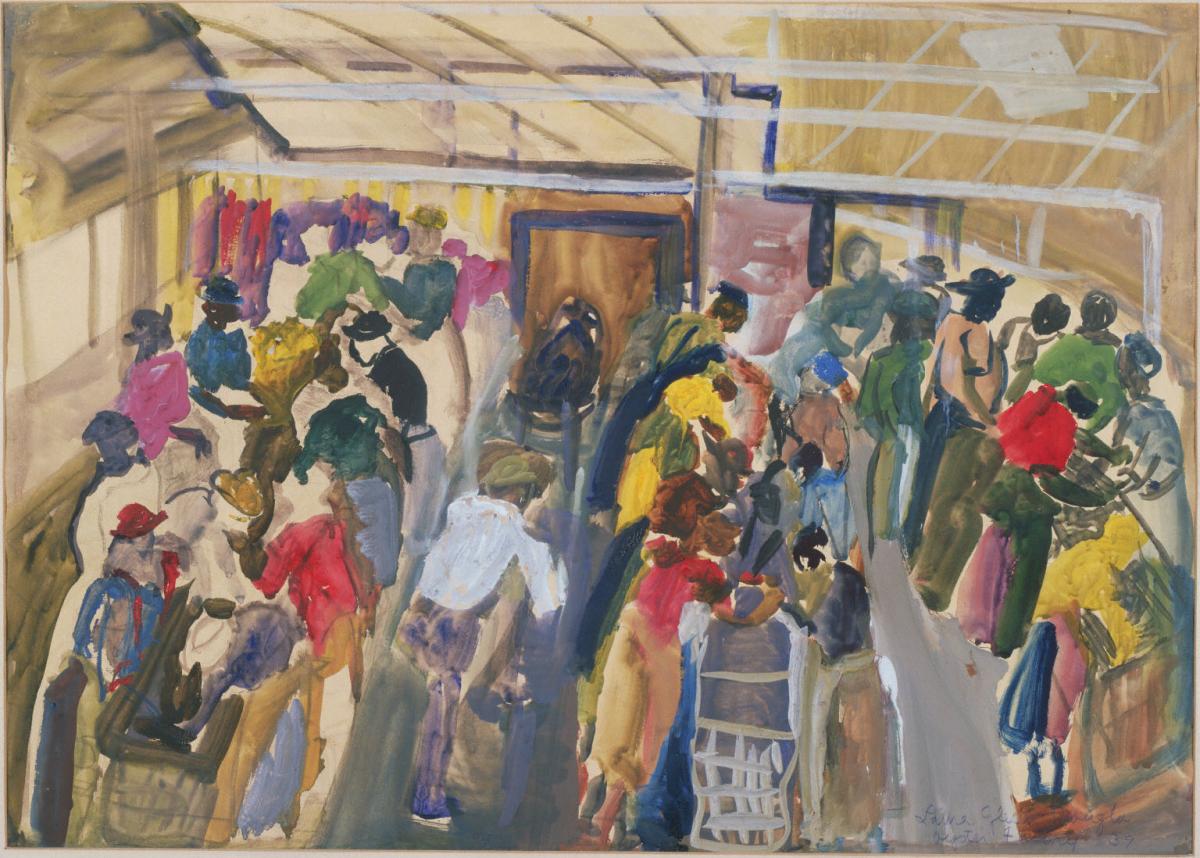Oyster Factory
Laura Douglas ( 1939 )

Laura Douglas’s career took her from South Carolina to New York, France, Italy, Germany, and Washington, DC. Although she dedicated her life to art, both producing and teaching, she never attained the level of recognition of her peers. Douglas, born and raised in Winnsboro, South Carolina, was interested in depicting the truth of the American South. She felt that despite its representation through musical and literary art, the South lacked visual portrayals.[1]
In the 1930s, Douglas began working on a series entitled Negro Symphonies, consisting of sketches of Black people in Charleston and Summerville, South Carolina, where she rented a studio and living space.[2] Oyster Factory depicts Black oyster shuckers who made up a once thriving part of South Carolina’s agricultural economy.[3] Douglas captures the hubbub of a factory floor with expressive strokes and intense color while contrasting the figures with the architectural elements of the ceiling. The work demonstrates Douglas’s control over the watercolor medium. While her subject matter was tied to the South, Douglas is widely recognized for bringing European techniques to South Carolina that she gained in her eight years studying art in Munich, Germany, and Paris, France. Subsequently, Douglas was praised by European critics and those familiar with European modernism, but little of her art was sold to her Southern audience, which she described as still “cling[ing] to the romantic realistic school.”[4]
In a letter to the Works Progress Administration’s Federal Art Project, Douglas stated that African Americans were an inferior or “primitive race,” and she thus chose to replicate cave drawings in her depictions of them.[5] This damning admission may account for the gestural strokes of Oyster Factory. Indeed, Douglas’s Symphony No. 2, Charleston, also in The Phillips Collection, reflects an aesthetic sensibility that approximates the linearity of many cave paintings.[6]
Text by Rebecca Shipman as part of the Seeing U.S. Research Project
[1] Lisë Swensson, “Laura Glenn Douglas and Her Art,” 1988, exhibition brochure, South Carolina State Museum, Columbia.
[2] “Individual Expressionism Style of Miss Douglas,” The News and Courier,1937. Phillips Collection Archive.
[3] “Early History of Mosquito Beach,” Historic Charleston Foundation, African American Civil Rights Grant Program of the National Parks Service, Department of Interior, https://www.historicmosquitobeach.com/home/history/early-days/, accessed December 8, 2023.
[4] Swensson, “Laura Glenn Douglas.”
[5] Laura Douglas, letter to the WPA/FAP, n.d. Property of the South Carolina State Museum.
[6]For more on Laura Douglas, see Adrienne L. Childs, “Difficult Conversations: Reading the Black South from Aunt Clemmy to Charity.”